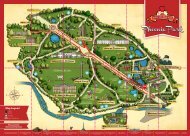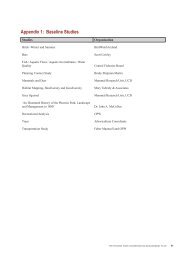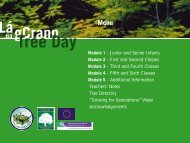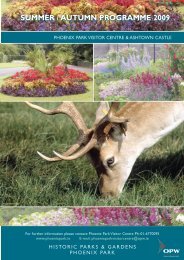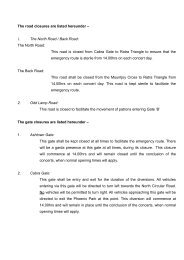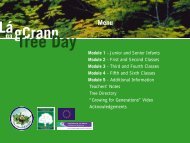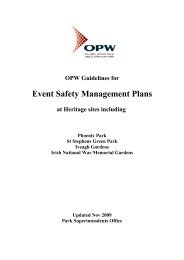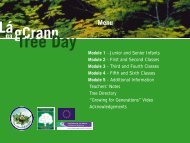The Birds of the Phoenix Park, County Dublin: Results of a survey in ...
The Birds of the Phoenix Park, County Dublin: Results of a survey in ...
The Birds of the Phoenix Park, County Dublin: Results of a survey in ...
You also want an ePaper? Increase the reach of your titles
YUMPU automatically turns print PDFs into web optimized ePapers that Google loves.
Blue Tit, Great Tit and Magpie were among <strong>the</strong> most widely distributed dur<strong>in</strong>g both <strong>the</strong> breed<strong>in</strong>g and <strong>the</strong><br />
w<strong>in</strong>ter <strong>survey</strong>s (Table 2). Jackdaw was <strong>the</strong> most numerous species recorded dur<strong>in</strong>g both <strong>the</strong> breed<strong>in</strong>g and<br />
w<strong>in</strong>ter <strong>survey</strong>s, and <strong>the</strong> totals recorded were relatively similar (777 <strong>in</strong> breed<strong>in</strong>g and 810 dur<strong>in</strong>g <strong>the</strong> w<strong>in</strong>ter),<br />
while Blue Tit and Woodpigeon were among <strong>the</strong> most numerous dur<strong>in</strong>g <strong>the</strong> breed<strong>in</strong>g period and Tufted<br />
Duck, Blue Tit and Black-headed Gull <strong>the</strong> most numerous dur<strong>in</strong>g <strong>the</strong> w<strong>in</strong>ter.<br />
Mute Swan, Wigeon, Kestrel, Golden Plover, Stock Dove, Stonechat, Wheatear, Spotted Flycatcher and<br />
Raven were all relatively scarce, with mostly just one or two birds recorded on just one occasion. Shoveler,<br />
Pochard and Common Gull were also relatively scarce, although <strong>the</strong> totals recorded were considerably large,<br />
ow<strong>in</strong>g to <strong>the</strong>ir congregatory behaviour dur<strong>in</strong>g <strong>the</strong> w<strong>in</strong>ter. House Sparrow was also quite scarce, recorded<br />
mostly <strong>in</strong> <strong>the</strong> Zoo grounds (section NE13), where it was quite numerous.<br />
No owl pellets were found dur<strong>in</strong>g pellet searches.<br />
<strong>The</strong> distribution <strong>of</strong> all species throughout <strong>the</strong> 29 sections <strong>of</strong> <strong>the</strong> park is summarised <strong>in</strong> <strong>the</strong> Appendix.<br />
Seasonal occurrence<br />
Species recorded dur<strong>in</strong>g <strong>the</strong> breed<strong>in</strong>g period only <strong>in</strong>cluded some resident species such as Mute Swan, Great<br />
Black-backed Gull, Stock Dove, Stonechat and Raven, and a suite <strong>of</strong> breed<strong>in</strong>g migrants, <strong>in</strong>clud<strong>in</strong>g Swift,<br />
Sand Mart<strong>in</strong>, Swallow, House Mart<strong>in</strong>, Wheatear, Sedge Warbler, Chiffchaff, Willow Warbler and Spotted<br />
Flycatcher. Species recorded dur<strong>in</strong>g <strong>the</strong> w<strong>in</strong>ter <strong>survey</strong> only <strong>in</strong>cluded <strong>the</strong> w<strong>in</strong>ter<strong>in</strong>g migrants Wigeon, Teal,<br />
Golden Plover, Snipe, Fieldfare, Redw<strong>in</strong>g, Brambl<strong>in</strong>g and Sisk<strong>in</strong> (Sisk<strong>in</strong> is resident, although additional<br />
migrants arrive <strong>in</strong> w<strong>in</strong>ter). Two resident species, Buzzard and Grey Wagtail, were also recorded dur<strong>in</strong>g <strong>the</strong><br />
w<strong>in</strong>ter only.<br />
Conservation concern<br />
Of <strong>the</strong> species recorded, some four are Red-listed on <strong>the</strong> recently updated <strong>Birds</strong> <strong>of</strong> Conservation Concern <strong>in</strong><br />
Ireland 1 (Lynas et al. 2007) and <strong>in</strong>clude Shoveler, Golden Plover, Black-headed Gull and Herr<strong>in</strong>g Gull,<br />
while a fur<strong>the</strong>r 24 are Amber-listed (Table 1). <strong>The</strong> species recorded also <strong>in</strong>clude one European SPEC 2 2<br />
species (Pochard), and a fur<strong>the</strong>r 14 SPEC 3 3 species.<br />
Importance <strong>of</strong> sections<br />
<strong>The</strong> number <strong>of</strong> species recorded overall <strong>in</strong> each section ranged between 20 and 47 (summer range 15 to 41<br />
species, w<strong>in</strong>ter range 12 to 41) (Table 3). Greatest diversity overall was recorded <strong>in</strong> both summer and w<strong>in</strong>ter<br />
<strong>in</strong> <strong>the</strong> two Zoo sections NE11 and NE13. <strong>The</strong> total number <strong>of</strong> species recorded overall was also relatively<br />
high <strong>in</strong> section NE1 (near <strong>the</strong> Chapalizod gates), while <strong>the</strong> Peoples Garden (NE14) also supported a<br />
relatively high number <strong>of</strong> species dur<strong>in</strong>g <strong>the</strong> w<strong>in</strong>ter <strong>survey</strong> (this section was not covered dur<strong>in</strong>g <strong>the</strong> summer).<br />
In contrast, fewest species were recorded (between 20 and 23 species) <strong>in</strong> sections border<strong>in</strong>g <strong>the</strong> road,<br />
<strong>in</strong>clud<strong>in</strong>g NE12 (Polo Grounds), NE10 and NE7, and also section SW7. Sections NE6, SW9, NE7 and NE10<br />
were relatively species-poor <strong>in</strong> summer, while sections NE12, SW12, NE10 and SW7 were species-poor <strong>in</strong><br />
w<strong>in</strong>ter.<br />
<strong>The</strong> overall density <strong>of</strong> birds was estimated at 6.9 birds/ha <strong>in</strong> summer and 8.7 birds/ha <strong>in</strong> w<strong>in</strong>ter. Section<br />
densities ranged between 1.1 (SW9) and 28.1 (NE13) <strong>in</strong> summer and between 1.6 (SW12) and 45.0 (NE13)<br />
<strong>in</strong> w<strong>in</strong>ter.<br />
<strong>The</strong> densities recorded <strong>in</strong> <strong>the</strong> two Zoo sections (NE11 & NE13) were highest, and were each over four times<br />
higher than <strong>the</strong> overall park density both <strong>in</strong> summer and w<strong>in</strong>ter. <strong>The</strong> three sections situated along <strong>the</strong><br />
nor<strong>the</strong>rn boundary <strong>of</strong> <strong>the</strong> park (NE1, NE3 and NE8) also supported relatively high densities <strong>in</strong> summer,<br />
while sections NE1 and SW8 (<strong>the</strong> latter is part <strong>of</strong> <strong>the</strong> Furry Glen) supported relatively high densities <strong>in</strong><br />
w<strong>in</strong>ter. In contrast, <strong>the</strong> Fifteen Acres (section SW9) supported <strong>the</strong> lowest density <strong>of</strong> birds <strong>in</strong> summer, while<br />
<strong>the</strong> adjacent play<strong>in</strong>g pitches (SW12), and sections NE2 and NE6 also supported relatively low numbers <strong>of</strong><br />
birds. With <strong>the</strong> exception <strong>of</strong> section NE6, <strong>the</strong>se sections supported fewest birds <strong>in</strong> w<strong>in</strong>ter also.<br />
1 Species <strong>in</strong> Ireland are divided <strong>in</strong>to three sub-lists, Red <strong>in</strong>clud<strong>in</strong>g <strong>the</strong> most severely threatened, Amber cater<strong>in</strong>g for species <strong>of</strong><br />
medium concern and Green hold<strong>in</strong>g <strong>the</strong> rema<strong>in</strong>der <strong>of</strong> species (Lynas et al. 2007).<br />
2 Species whose global populations are concentrated <strong>in</strong> Europe, and which have unfavourable conservation status <strong>in</strong> Europe (BirdLife<br />
International 2004).<br />
3 Species whose global populations are not concentrated <strong>in</strong> Europe, but which have unfavourable conservation status <strong>in</strong> Europe<br />
(BirdLife International 2004).<br />
5




